The unyielding Cristina of Borbón
Thursday, June 26, 2014
 For a long time, Cristina of Borbón represented the modern side of Spain’s royal family. Born in 1965, she was the first female Spanish royal to earn a university degree (in political science); in 1991 she told reporters that she would marry for love and that her husband would be a normal, uncomplicated man; in 1992 she shared a Barcelona apartment with a girlfriend from her sailing circle; and in 1993 she started working for bank La Caixa on a monthly salary of €1,200. For a long time, Cristina of Borbón represented the modern side of Spain’s royal family. Born in 1965, she was the first female Spanish royal to earn a university degree (in political science); in 1991 she told reporters that she would marry for love and that her husband would be a normal, uncomplicated man; in 1992 she shared a Barcelona apartment with a girlfriend from her sailing circle; and in 1993 she started working for bank La Caixa on a monthly salary of €1,200.
The most independent member of Spain’s royal family was also one of its most beloved. The day she married Olympic handball player Iñaki Urdangarin in Barcelona, 200,000 people came out to applaud as the new Duke and Duchess of Palma went by. That was in October 1997.
Fifteen years later, “popular indignation” led the city of Palma de Mallorca to change the sign on a street that had been named in their honor: it is now known simply as La Rambla. The title of the Duke and Duchess of Palma had been a surprise wedding gift from Cristina’s father, King Juan Carlos.
Once in high demand to hand out prizes at ceremonies, attend public events and represent the Spanish Crown, Cristina sealed her own fate when she decided to remain loyal to her husband after he had morphed from a perfect son-in-law to a “toxic man” following the Nóos scandal.
They met in the summer of 1996, at an event organized by the Spanish Olympic Committee, and announced their engagement on April 30, 1997, after a nine-month relationship. Back then, Cristina was earning 200,000 pesetas (€1,202) a month at La Caixa, while Urdangarin had an annual salary of 10 million pesetas (€60,101) as a handball player for the Barcelona team. The 30-year-old sportsman was also completing a degree in business administration and seemed concerned about his job prospects.
But his lifestyle began experiencing exponential growth. In 2004, after taking out a loan from La Caixa and borrowing €1.2 million from Juan Carlos, the couple bought a luxury mansion in the exclusive Barcelona neighborhood of Pedralbes for €6 million. Refurbishing the place allegedly cost an additional €3 million.
So what happened in between this period of making ends meet and the luxury home? Urdangarin did a master’s degree at the Esade business school in Madrid, where he met Diego Torres, his future business partner and the man who ultimately dragged Cristina de Borbón into a courthouse. At the height of the Nóos scandal, in March 2012, Torres became furious when Urdangarin’s lawyer objected to dropping Torres’ wife from the investigation. In revenge, he gave investigators reams of personal email exchanges containing compromising information relating to Urdangarin and his wife.
But not even this made Cristina distance herself an inch from her husband. She never offered to file for divorce or renounce her theoretical rights to the throne, even though surveys kept showing that the Nóos case was severely eroding the monarchy’s good standing.
The king’s public apology for his elephant-hunting expedition to Botswana went some way towards lifting the Crown’s popularity ratings again, but public support has yet to return to pre-Nóos levels.
The Infanta is sixth in line to the throne, so renouncing her rights would have no practical consequences. It would not even affect her children, who would climb one rung in the succession ladder. Yet she never made such a gesture to her father, and neither did he ask for it. It remains to be seen whether she will offer it to the new king, her brother Felipe VI, depending on how her legal situation develops.
In any case, the Duke and Duchess of Palma have not appreciated the isolation tactics implemented by the former head of the Royal Household, Rafael Spottorno, in an effort to protect the king and the monarchy. Both Cristina and her husband viewed the strategy as an advance condemnation of their own persons. Then again, they never thought things would ever go this far.
Cristina was removed from the official royal schedule in October 2011, and did not even attend her father’s abdication ceremony or her brother’s coronation last week. Even though the two siblings had been very close, Felipe has avoided being seen in public with Cristina ever since the Nóos scandal broke.
The princess was convinced that she had become a scapegoat. The lawyer her father hired as her defense attorney, Miquel Roca, one of the founding fathers of the Spanish Constitution, quickly announced an appeal when the judge in charge of the case summoned her for questioning a second time. But the royal family convinced Cristina that it would be in her own best interest to give testimony, cut “the torture” short, and avail herself of this last chance to send out the message that she was cooperating with the justice system.
Finally, on February 8, the Infanta was forced to head down the “slope of shame” that leads into the Palma courthouse, although she covered the distance in a car. Once inside, she gave evidence as an official suspect in a tax fraud and money laundering investigation in connection with her husband’s questionable sources of funding through the Nóos Institute.
Nobody from the royal family was there with her, just her lawyers, who had trained her for something that no monarch’s child is ever trained to do: provide explanations.
“I trusted my husband,” was the phrase she repeated many times over in her court statement. But she failed to convince Judge Castro. “The endless resorting to the claim of ignorance and faulty recollection” shown by Cristina throughout the session made the magistrate decide not to drop the investigation against her. “Whether the explanation for this attitude resided in the trust, veneration or love that she professed for her husband is not for me to judge,” added Castro.
But sources at La Zarzuela, the royal residence, are blaming the stubborness of a woman in love for the decline in the monarchy’s popularity ratings, and for the first shadow cast over Spain’s new king.
 0
Like
Published at 3:05 PM Comments (0)
0
Like
Published at 3:05 PM Comments (0)
Felipe VI becomes the new king of Spain
Thursday, June 19, 2014
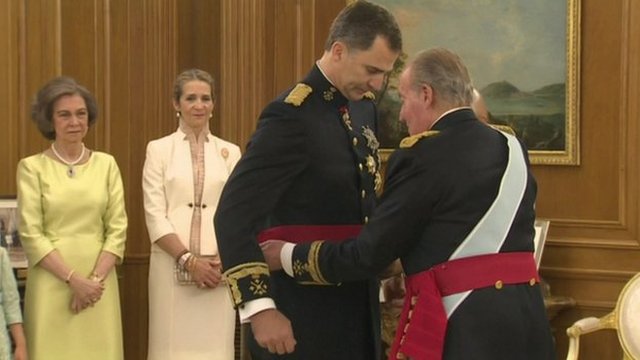
Felipe VI is the new king of Spain. Juan Carlos’s son legally took over as the country’s new monarch at midnight when the abdication law signed on Wednesday came into force.
The low-key ceremony to proclaim Felipe king began at 9.30am on Thursday, when Juan Carlos presented him with the sash of the commander-in chief of the armed forces, a position held by the head of state as per the Spanish Constitution.
After the ceremonial act at La Zarzuela palace, the royal residence, father and son embraced each other and the new monarch greeted his wife, Queen Letizia, and his daughters Leonor, the new Princess of Asturias, and Sofía.
At 10am, a motorcade left the palace for Congress, in downtown Madrid, where the actual coronation ceremony was to take place in recognition of the fact that Spain is a constitutional monarchy.
Amid heavy security measures, a black Rolls-Royce took the new monarchs and their daughters to the lower house of parliament, where 325 deputies, 259 senators and other elected officials awaited them.
The new royals arrived at Congress three minutes before 10.30am, where they stood on a red dais to listen to a live rendition of the Spanish national anthem before moving inside the building. Felipe VI stood at attention with Queen Letizia standing to his left and their two young daughters to his right.
Felipe VI then inspected the troops standing in formation on the Carrera de San Jerónimo. Afterwards, the royal family walked up the steps to cries of “Felipe! Felipe!” from the crowd gathered outside Congress and waving Spanish flags. A standing ovation awaited them inside the lower house, after which Congress speaker Jesús Posadas delivered a speech.
Posadas had words of gratitude for the 39 years of service given by Juan Carlos’ wife, Queen Sofía, who held back tears as she received a standing ovation of her own while her eldest daughter Elena stood by her side.
Juan Carlos had chosen not to be in Congress so as not to take the focus away from his son.
There was no actual crowning per se – no Spanish monarch has used a crown since the days of the Catholic monarchs – but rather a solemn proclamation. At 10.47am, a serious-looking Felipe VI took his oath, Posadas proclaimed him king, and Congress cried out “Viva el rey! Viva España!” as the national anthem was played again.
Felipe then took to the stand to deliver his first speech as Spain’s new king, describing his reign as “a renewed monarchy for new times.”
Speaking about the unity but also the plurality of Spain, in recognition of regions where separatist sentiment is high such as Catalonia and the Basque Country, the king underscored his respect for the Constitution and said that “the reign of a constitutional king is now getting underway.”
Felipe VI went on to express his desire to become a symbol of national unity. “The parliamentary monarchy can and must continue to provide a fundamental service [to the nation],” he said.
Since his father Juan Carlos announced his abdication earlier this month, there have been strong displays of republican sentiment in many Spanish cities, including Madrid.
“The Crown must constantly earn citizens’ appreciation, respect and trust,” Felipe said.
Spain’s new king also acknowledged the economic crisis and the widespread disaffection for politicians. “Today, more than ever, citizens are rightly demanding that public officials lead by example,” he said.
Calling for a renewed spirit of governance based on the best interest of Spaniards, Felipe VI said “today I would like for us to look forward to the future.”
King Felipe ended his speech with a quote from Don Quixote: “A man is not worth more than another man if he does not do more than him” and hoped that Spaniards would feel proud of his own day-to-day work. He then thanked his audience in Castilian Spanish, Catalan, Basque and Galician.
 0
Like
Published at 3:01 PM Comments (8)
0
Like
Published at 3:01 PM Comments (8)
Coronation without presence of foreign royals
Thursday, June 12, 2014
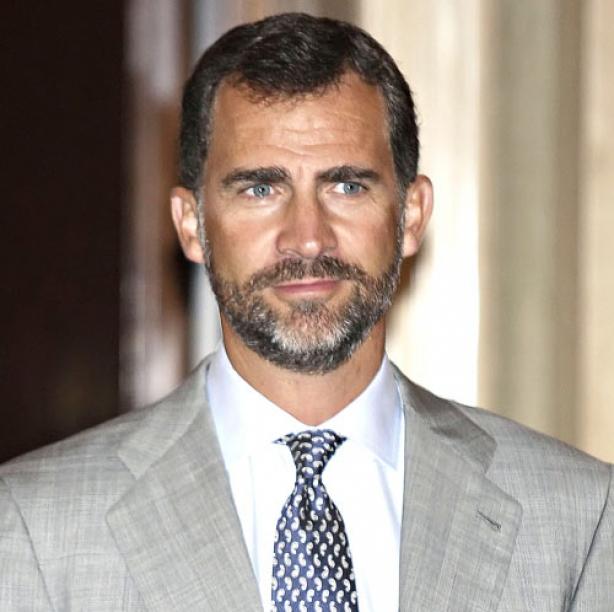 Not one representative of other European royal families, nor any foreign heads of state, will attend the coronation ceremony of Felipe VI, which will take place on June 19 in a joint session in Spain’s Congress and Senate in Madrid. “We have very little time, and there is no room in the benches of the lower chamber,” explained a Royal Household spokesperson on Thursday. “We aren’t going to make people come just to leave them outside.” Not one representative of other European royal families, nor any foreign heads of state, will attend the coronation ceremony of Felipe VI, which will take place on June 19 in a joint session in Spain’s Congress and Senate in Madrid. “We have very little time, and there is no room in the benches of the lower chamber,” explained a Royal Household spokesperson on Thursday. “We aren’t going to make people come just to leave them outside.”
Nor will there be a Mass after the ceremony, as was the case when Juan Carlos I was sworn in as king in 1975. There will, however, be military honors outside Congress, and Felipe VI will attend the ceremony in his military uniform, given that when he is crowned king he will automatically become the leader of Spain’s armed forces, as established by the Constitution.
The Zarzuela Royal Palace has yet to confirm which members of the Spanish royal family will be present at the June 19 ceremony. Nor have they confirmed whether the current king and queen will attend. There is intense media interest as to whether the king’s daughter, Cristina, and her husband, Iñaki Urdangarin, will be present, given that both are currently caught up in a corruption scandal relating to the king’s son-in-law’s business affairs.
The palace has justified the vagueness of the details concerning the ceremony given the lack of precedent. “With the abdication, all we had in the Constitution were two lines of text,” a spokesman said. “The only abdication was that of Felipe V [in 1724], and that didn’t last long – his son died eight months later.”
On the day of his coronation, Felipe VI will read a speech that will set the tone and the agenda for his reign. According to the Royal Household, Congressional speaker Jesús Posada is likely to read another speech beforehand.
After he becomes king, Felipe VI is expected to begin a presentation tour around Spain and several countries abroad. He will be accompanied by Princess Letizia, and is likely to visit Morocco, France and Portugal first.
 0
Like
Published at 4:19 PM Comments (0)
0
Like
Published at 4:19 PM Comments (0)
Shortly, The Crown Princess of Spain
Tuesday, June 10, 2014
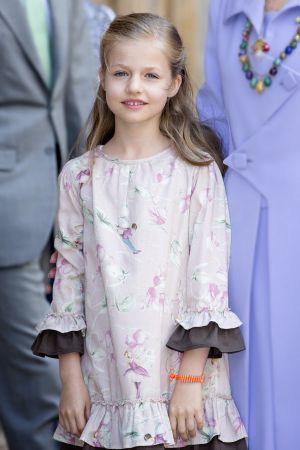
The explanations began on the day that Leonor de Borbón y Ortiz asked: “Why do people take so many pictures of us?”
That is when Felipe and Letizia told Leonor that her grandparents were the king and queen of Spain.
It was reportedly harder for her mother to answer the next question: “So what do you do for a living?” The reply was: “I work for Spain, to improve the country.”
And so at the age of eight, Leonor already knows that she is part of the royal family and that one day, she too will be queen of Spain.
On the day that her father becomes king, Leonor will become the heir to the throne and bear the title of Princess of Asturias. When she turns 18, she will swear to uphold the Spanish Constitution, as her father did before her.
Unlike other royal families in Europe, the Spanish monarchy still preserves an old law that favors male descendants over female ones in the line to the throne. This means that if a baby boy were born to Felipe and Letizia, he would skip ahead of his sisters to become the crown prince – unless the Constitution were to be changed.
But it seems unlikely that Letizia has any further plans for motherhood.
On May 2, when Juan Carlos’ decision to abdicate was still under wraps, Leonor attended her first official act at the San Javier airbase in Murcia. Her presence there was no coincidence. Sources at the royal residence, La Zarzuela, said that this marks the beginning of Leonor’s public life.
For now, though, her parents want her to keep a low profile. “She’ll have time enough for all of that,” said Don Felipe on one occasion.
But things are happening fast all of a sudden. Leonor is expected to be there at the ceremony that will turn her father into Felipe VI.
The infanta is about to finishthe third grade at a secular private school, Nuestra Señora de los Rosales, where monthly student fees are €700. Leonor’s younger sister Sofía also attends this school.
They say that Leonor is an attentive student, who takes ballet lessons and is studying the history of the Bourbons, the dynasty to which she belongs. In future, she will receive some military training to prepare her for her role as chief of the armed forces. She is also expected to study abroad for a while, as her father did in Canada.
The royal palace will not provide any more details about plans for Leonor, insisting on the need to protect the child’s privacy as far as is possible.
Physically, Leonor is a lot like her grandmother, Queen Sofía, at the same age. She is an earnest child who likes to observe things around her and makes sure that her little sister is obedient at all times. In private she is said to be more restless and witty. A Spanish scientist once revealed a now-famous anecdote told to him by Letizia, in which Leonor said to her sister: “Eat your vegetables – they contain anti-oxidants.”
“They are very well-behaved little girls,” say sources at the palace who are in touch with the family on a daily basis. Just as Letizia places high demands on herself, she also places them on her children.
Nearly two years ago, King Juan Carlos expressed a desire to have his picture taken with his son and eldest granddaughter at the palace gardens. This photograph, which illustrates the family’s dynastic lineage, was there in the background when the king announced his abdication on Monday.
The youngest, Sofía, was reportedly jealous that she was not allowed to pose with “Grandpa.” In the end, Juan Carlos had another picture taken in which Sofía was included, but that shot remains in the family’s private photo album. The portrait of Spain’s future monarchy is clear.
 0
Like
Published at 1:34 PM Comments (0)
0
Like
Published at 1:34 PM Comments (0)
A middle-class queen
Tuesday, June 10, 2014
If she had not married the man she did, Letizia Ortiz Rocasolano might have spent Monday morning covering the news story live herself.
But the monarch who has just abdicated happens to be her father-in-law, and has been for the last decade, ever since she married Prince Felipe on May 22, 2004.
Letizia, a former journalist, no longer covers the news. Rather, she is in the news herself: the gossip magazines and television talk shows are forever discussing her choice of clothes, shoes and hairdos, analyzing her thinness and debating her outbursts and nocturnal jaunts.
But the picture of Letizia that has emerged from other media reports is one of increasing self-reliance and greater spontaneity than is customary among royal families.
Letizia, 41, has kept her own agenda since 2007, and her activities include support for victims of rare diseases and cooperation with the World Health Organization on nutrition issues.
Other personal habits have introduced a touch of the middle class into the Spanish monarchy: it is not difficult to find the princess sitting inside one of the cinemas showing original-version movies in Madrid’s Plaza de los Cubos, going to indie music concerts, or attending the capital’s annual Book Fair in jeans (though she gets a private visit).
The princess thinks, and (here is the real news) sometimes says what she thinks. As her own confidence in her tasks has grown with the years, so has her critical spirit come to the fore.
“It is not the same calling it aid or calling it a bailout; it is not the same calling it a recession or calling it negative growth; it is not the same calling it restructuring or calling it cuts,” she said a year ago at a language seminar in San Millán de la Cogolla (La Rioja). It was the kind of liberty that Queen Sofía, Juan Carlos’ wife, would never have taken.
But Letizia has the unprejudiced gaze of a perfect representative of the middle class – someone who has traveled on the subway, taken out a mortgage to buy an apartment in a Madrid suburb, and brought emotional baggage to the relationship (in 1998 she had married her former high-school literature teacher; the couple were divorced a year later).
When she married the crown prince, Letizia Ortiz gave up a journalism career that had taken off in 2003, when she became the host of the primetime newscast on state broadcaster TVE. She covered the 9/11 terrorist attacks, the Iraq invasion and the sinking of the Prestige oil tanker off the coast of Galicia. Her father was a journalist, as was her grandmother. She studied journalism at Complutense University in Madrid and worked on a PhD in Mexico. She dabbled in print journalism for a while, but broadcast work was her thing.
When she met Felipe at a dinner party at the home of a fellow TVE worker, Letizia’s career was on the rise. In 2000 she had received an award for journalists under the age of 30 from the Madrid Press Association.
So it was not just the crown prince who had to seriously ponder the consequences of marrying a woman who was a stranger to aristocratic circles; Letizia also had to assess what she would lose and what she would gain from taking the step. Everyone says theirs was a marriage of love, and certainly the pictures of the couple always display their tenderness toward each other.
Over the course of a decade, the princess has had to deal with the death of her sister Erika and the Nóos corruption scandal affecting other members of the royal household. But there has also been the birth of her daughters Leonor and Sofía. Letizia has tried to create normal living conditions: she and Felipe take their kids to school and put them to bed at night themselves. Their house, a residence built in 2000 known as the Prince’s Pavilion, is an attempt to bring some warmth into the coldness of the royal residence. It is likely that once they become King Felipe VI and Queen Letizia, they will keep on living there.
 0
Like
Published at 10:32 AM Comments (0)
0
Like
Published at 10:32 AM Comments (0)
King Juan Carlos will lose immunity
Friday, June 6, 2014
King Juan Carlos’s decision to relinquish the throne in favor of his son Felipe will have some legal consequences for himself and his immediate family.
On the day that he signs the abdication document, Juan Carlos will lose the immunity he enjoys as head of state, and that privilege will be passed on to the new monarch, Felipe VI.
Also on that day, his daughters Elena and Cristina will no longer be a part of the royal family per se, but rather relatives of the king with no representation duties at official events. Cristina has been absent from the royal agenda since December 2011, when her husband Iñaki Urdangarin became involved in an embezzlement investigation.
The royal family will then comprise six members: Felipe, his wife Letizia, their daughters Leonor and Sofía, and the former monarchs Juan Carlos and Sofía, said sources at the royal palace.
Although in theory Juan Carlos will be liable for prosecution just like anyone else, Congress could decide to grant him a special aforado status, whose recipients can only be tried by a higher court.
Don Juan Carlos and his son Felipe were seen together in public on Tuesday, a day after the abdication announcement, at a military ceremony in San Lorenzo de El Escorial. Juan Carlos remains head of the armed forces until the handover.
A small group of pro-monarchy enthusiasts cheered the incoming and outgoing monarchs at the event.
“I am very happy. The king has done a very good job. I think the abdication could not be helped,” said a woman named Carmen. “We already had a Philip the Fair, and now we are going to have a Philip the Great.”
 0
Like
Published at 9:47 AM Comments (0)
0
Like
Published at 9:47 AM Comments (0)
Felipe VI will be crowned King of Spain on June 18
Friday, June 6, 2014
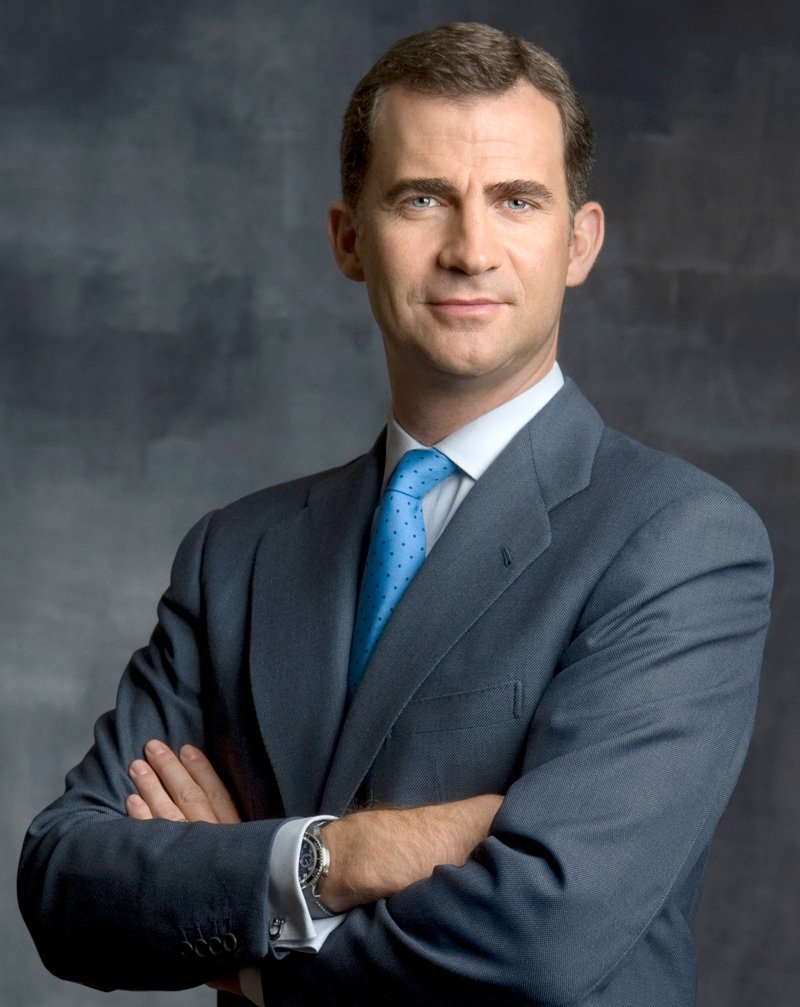
Felipe VI will be crowned the new king of Spain on June 18, and the ceremony will take place inside Congress, it was announced on Tuesday.
Although Juan Carlos I has sat on the throne for nearly four decades, Spain still lacks a law regulating the procedure to be followed for a royal succession.
That is why the government now needs to pass fast-track legislation covering every aspect of the handover.
The executive on Tuesday approved a draft law that will make the abdication effective, which will now begin its passage through parliament in Congress. An absolute majority in next Wednesday’s vote is required for the bill to pass and move to the Senate for final approval.
It is expected that the ruling Popular Party, the Socialists and the center party UPyD will vote in favor. Sources at CiU said the Catalan nationalist coalition will “most likely vote in favor.”
The Basque Nationalist Party (PNV) was due to take a stand on the issue on Tuesday. Other small groups in Congress have expressed a desire for a referendum.
The exact date when the law goes into effect is set to coincide with the proclamation of the new monarch, as there can be no transitional period. In the meantime, “the king continues to be the king to all effects and purposes,” said an expert in royal affairs.
The new law will not, however, establish the outgoing monarch’s new legal status, as he will no longer enjoy immunity from the courts, a condition that is exclusive to the head of state.
However, under separate legislation that was recently approved, the monarch’s wife will be an aforada, meaning that she can only be tried by the Supreme Court, and not in the lower courts. This privilege was going to be awarded to Queen Sofía, but will now instead go to Letizia, Felipe’s wife.
 0
Like
Published at 9:43 AM Comments (0)
0
Like
Published at 9:43 AM Comments (0)
A brief chronology of King Juan Carlos’ 76 years
Wednesday, June 4, 2014
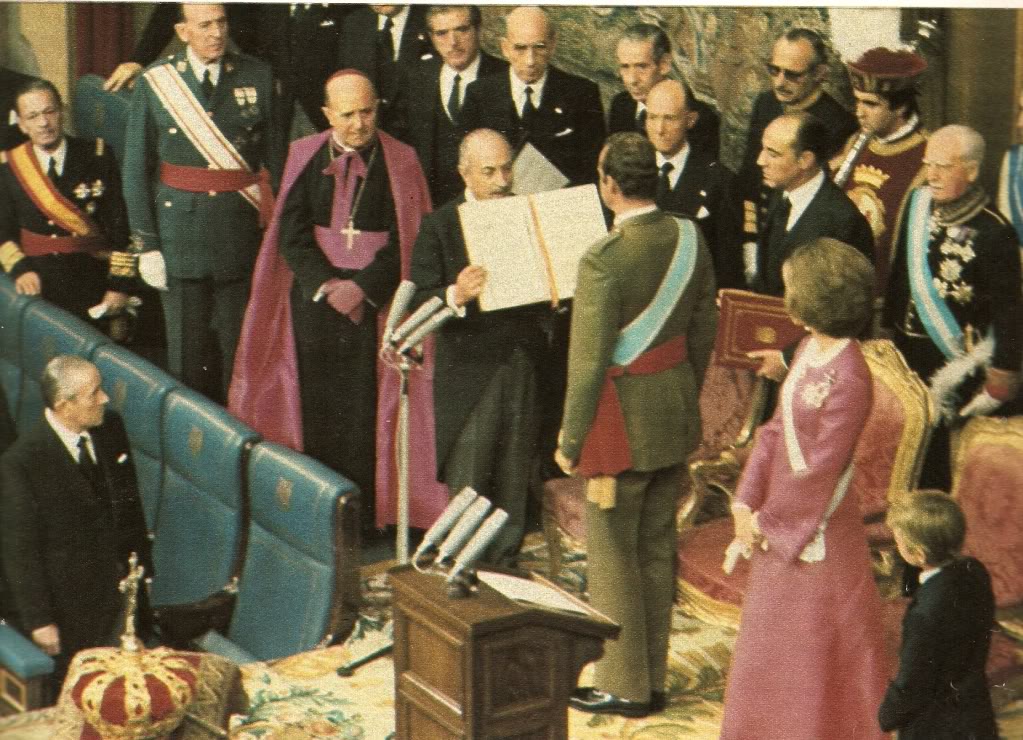
January 5, 1938. Don Juan Carlos de Borbón is born in Rome, Italy.
May 14, 1962. He marries Sofía of Greece in Athens.
December 20, 1963. Infanta Elena is born in Madrid.
June 13, 1965. Infanta Cristina is born in Madrid.
January 30, 1968. Prince Felipe is born in Madrid.
July 22, 1969. Don Juan Carlos is proposed as successor to General Franco with the title of king, according to the 1947 Succession of the Leadership of the State law.
November 22, 1975. He is proclaimed King of Spain following the death of Franco.
May 14, 1977. The Count of Barcelona gives up his dynastic rights in favor of his son, Juan Carlos.
January 30, 1986. Prince Felipe swears loyalty to the Constitution and the king.
March 18, 1995. Infanta Elena marries Jaime de Marichalar in Seville Cathedral.
October 4, 1997. Infanta Cristina marries Iñaki Urdangarin in Barcelona.
May 22, 2004. Prince Felipe and Letizia Ortiz marry in Madrid’s Almudena cathedral.
November 13, 2007. The Royal Household announces the separation of Infanta Elena and Jaime de Marichalar.
2008. The Palma Arena corruption case erupts. Judge Castro investigates the construction of the Palma sports complex, where costs shot up from €48 million to €110 million. The inquiry also sparks the Nóos case involving Infanta Cristina’s husband Iñaki Urdangarin.
2009. Infanta Cristina and Iñaki Urdangarin move to Washington, D.C..
December 15, 2009. Infanta Elena and Marichalar complete their divorce in a Madrid court.
2010. The king undergoes an operation to remove a benign tumor from his right lung.
2011. The king damages his left Achilles’ tendon and has his right knee replaced.
In June the judge names Diego Torres, Iñaki Urdangarin’s business partner at the non-profit Nóos Institute, as an official suspect in the case. In December Urdangarin is also targeted as an official suspect. The Royal Household relieves him of all official duties.
In his traditional televised speech on Christmas Eve, the king says: “Justice is the same for everyone.”
2012. The king undergoes an operation to replace his right hip after breaking it on an elephant-hunting trip to Botswana. A short while later he dislocates the same hip and also has his left hip replaced because of arthritis.
February 25-26, 2012. Urdangarin testifies in front of Judge José Castro for 22 hours.
2013. Don Juan Carlos suffers a slipped disc and undergoes another hip operation in September.
Infanta Cristina and her family relocate to Geneva, Switzerland.
January 20, 2013. The judge accuses Urdangarin and his business partner of making “disproportionate profit” and orders them to post a €8.1 million bail bond.
February 23, 2013. The judge summons Urdangarin to testify for tax fraud.
April 3, 2013. Judge Castro names Infanta Cristina as an official suspect in the case. The Palma de Mallorca High Court later removes her name from the list of official suspects because of a lack of evidence.
November 14, 2013. Public prosecutor Pedro Horrach says there is no evidence of any criminality in the Infanta’s actions in relation to her husband’s business dealings and therefore she should no longer be investigated in the case.
January 8, 2014. The investigating judge names Infanta Cristina as an official suspect for a second time after finding that there is evidence of money laundering and tax fraud in relation to Aizoon, the company she jointly owns with her husband.
February 8, 2014. Princess Cristina testifies before the judge.
March 6, 2014. Queen Sofía brings Prince Felipe, Princess Letizia, the Infantas Elena and Cristina, and their children together at a ceremony to mark the 50th anniversary of the death of her father, Paul of Greece, in Athens. The last time they had all been seen together was in June 2013 on the occasion of a Mass to commemorate the 100th anniversary of the birth of King Juan Carlos’ father, Don Juan.
April 2014. The royal family celebrates Easter in Palma de Mallorca without the Infanta Cristina and Urdangarin.
The king begins a tour of various countries in the Persian Gulf.
June 2, 2014. Prime Minister Mariano Rajoy announces that the king has communicated to him his decision to abdicate.
 0
Like
Published at 1:33 PM Comments (0)
0
Like
Published at 1:33 PM Comments (0)
King addresses Spaniards via television message
Wednesday, June 4, 2014
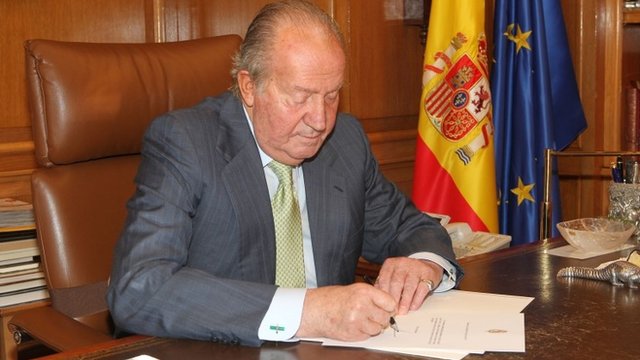
With a delay of half-an-hour, King Juan Carlos appeared on Spanish television at 1pm on Monday, just hours after Prime Minister Mariano Rajoy announced that the monarch was to abdicate. What appears below is an edited translation of his full speech.
“When I was proclaimed king, nearly four decades ago, I took on a firm commitment to serve Spain’s general interest, moved by the desire to make citizens the agents of their own destinies and for our nation to become a modern democracy, one that was fully integrated into Europe.
“I proposed leading the exciting national task of allowing citizens to choose their legitimate representatives and to carry out the great, positive transformation that we all needed so much."
“Today, when I look back, I cannot help feeling proud and grateful to you. I proposed leading the task of allowing citizens to choose legitimate representatives”
“Proud because of the many good things we have achieved together throughout the years."
“And grateful for your support, which has made my reign – which I began as a young man at a time of great uncertainty and difficulty – a long period of peace, freedom, stability and progress."
“Loyal to the political wishes of my father, from whom I inherited the historical legacy of the Spanish monarchy, I have always wanted to be a king for all Spaniards. I identified with your aspirations, felt joy at your successes and suffered when pain or suffering overwhelmed you.”
In a speech that made a point of expressing hope in the future, Juan Carlos nevertheless made a reference to the crisis and its effects.
“The long, deep economic recession we are enduring has left serious scars in the social fabric, but it is also pointing out a future path that is filled with hope."
“These difficult years have enabled us to do some critical stocktaking to analyze our mistakes and limitations as a society"
“On the other hand, they have also reactivated the proud awareness of what we have been and continue to be: a great nation. All of this has awakened within us a desire for renewal, for self-improvement, for correcting our mistakes and for paving the way to a decidedly better future"
“A new generation is legitimately demanding a central role in the forging of this future. A younger generation with new energy has the determination to undertake the transformation and reforms demanded by the current situation."
"My sole ambition has always been, and always will be, to help attain progress for all Spaniards in a climate of freedom”
“I want the best for Spain, to which I have dedicated my entire life and at whose service I have placed all my ability, my enthusiasm and my work."
“My son Felipe, Prince of Asturias and heir to the Crown, embodies the stability that is a defining feature of our monarchy."
“When I turned 76 last January, I felt that the time had come to prepare the handover to make way for someone who is in the best possible conditions to maintain that stability."
“The Prince of Asturias has the maturity, training and sense of responsibility that are necessary to fully guarantee his position as head of state and begin a new period of hope that combines acquired experience with the thrust of a new generation.
“I am sure he will always be able to count on the support of Princess Letizia."
“And so, guided by the firm belief that I am doing the best service to Spaniards, and now that I have recovered physically and gone back to my institutional activities, I have decided to bring my reign to an end and abdicate the Spanish crown."
“I wish to express my gratitude to the Spanish people, to all the individuals who have embodied the state’s powers and agencies during my reign, and everyone who has generously and loyally helped me perform my duties."
“My gratitude also goes out to Queen Sofia, whose cooperation and generous support have never failed me."
“Spain will always be in my heart.”
 0
Like
Published at 10:20 AM Comments (1)
0
Like
Published at 10:20 AM Comments (1)
Spam post or Abuse? Please let us know
|
|